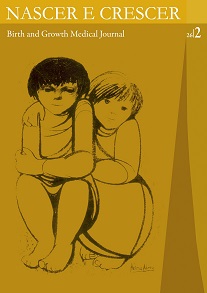PEDIATRIC PRIMARY HYPERPARATHYROIDISM: A RARE CAUSE OF NEPHROLITHIASIS
DOI:
https://doi.org/10.25753/BirthGrowthMJ.v26.i2.9656Keywords:
Children, hypercalcemia, Primary hyperparathyroidism, nephrolithiasisAbstract
Introduction: Primary hyperparathyroidism is a rare disease in the pediatric age group and a rare cause of nephrolithiasis. It results from an excessive production of the parathyroid hormone due to abnormalities within the parathyroid glands.
Case report: The patient was a twelve-year-old male admitted in the paediatrics emergency department with intermitent flank pain and dysuria. An abdominal ultrassound identified nephrolithiasis. Laboratorial tests showed hypercalcemia, an increased serum level of parathyroid hormone and hypercalciuria. A primary hyperparathyroidism was diagnosed and the ultrassound plus scintigraphy of both thyroid and parathyroid glands revealed a right lower parathyroid adenoma. A right lower parathyroidectomy was performed with regularization of the calcium and parathyroid hormone levels. The histopathology revealed main cells hyperplasia and genetic tests were negative.
Conclusion: Primary hyperparathyroidism should be considered in the differential diagnosis of nephrolithiasis to allow an early intervention and prevent organ damage.
Downloads
References
Roizena J, Levine M. Primary hyperparathyroidism in children
and adolescentes. Chin Med Assoc. 2012; 75: 425–34.
Vieira H, Calado R, Martins A, Olimpia Cid M.
Hiperparatiroidismo primário na criança – a propósito de um
caso clínico. Saúde Infantil 2013; 35: 40-2.
Kollars J, Zarroung A, Heerden J, Lteif A, Stavlo P, Suarez
L, et al. Primary Hyperparathyroidism in Pediatric Patients.
Pediatrics 2005; 115: 974-80.
Alagaratnam S, Kurzawinski T. Aetiology, Diagnosis and
Surgical Treatment of Primary Hyperparathyroidism in
Children: New Trends. Hormone research in paediatrics
; 83: 365-75.
Salman P, González G, González H, Arteaga U.
Hiperparatiroidismo primario en el adolescente. Caso
Clinico. Revista médica de Chile 2008; 136: 1301-6.
Rolighed L, Rejnmark L, Sikjaer T, Heickendorff L, Vestergaard
P, et al. Vitamin D Treatment in Primary Hyperparathyroidism:
A Randomized Placebo Controlled Trial. J Clin Endocrinol
Metab. 2014; 99:1072-80.
Wilhelm SM, Wang TS, Ruan DT, Lee JA, Asa SL, et al. The
American Association of Endocrine Surgeons Guidelines
for Definitive Management of Primary Hyperparathyroidism.
JAMA Surg. 2016.
George J, Acharya S, Bandgar T, Menon P, Shah N. Primary
hyperparathyroidism in children and adolescentes. The
Indian Journal of Pediatrics 2010; 77: 175-8.
Menon P, Dayal D, Rao SG, Bhattacharya A, Narasimha Rao
KL. Childhood parathyroid adenoma: a rare but important
cause of nephrolithiasis. Journal of Pediatric Endocrinology
and Metabolism, 2016; 29:853-6.
Mancilla E, Levine M, Adzick N. Outcomes of minimally
invasive parathyroidectomy in pediatric patients with
primary hyperparathyroidism owing to parathyroid
adenoma: A single institution experience. Journal of
pediatric surgery, 2016; 60-9.
Li C, Yang C, Wang S, Zhang J, Kong R, Ouyang J. A 10-
year retrospective study of primary hyperparathyroidism in
children. Experimental and clinical endocrinology & diabetes.
Official journal, German Society of Endocrinology [and]
German Diabetes Association 2012; 120: 229-33.
Downloads
Additional Files
- Sem título (Português)
- Ecografia da tiroide e paratiroide: nódulo sólido, hipoecogéneo e homogéneo com 19x7x5mm localizado na paratiroide direita, sugestivo de adenoma. (Português)
- Cintigrafia da tiroide e paratiroide: tecido paratiroideu hiperfuncionante ao nível da paratiroide inferior direita. (Português)
- Glândula paratiroideia inferior direita excisada, cujo exame histológico revelou hiperplasia de células principais. (Português)
- declaração autor (Português)
- artigo - após revisão (Português)
- resposta ao revisor A (Português)
Published
How to Cite
Issue
Section
License
Copyright and Authors' Rights
All articles published in Nascer e Crescer - Birth and Growth Medical Journal are Open Access and comply with the requirements of funding agencies or academic institutions. For use by third parties, Nascer e Crescer - Birth and Growth Medical Journal adheres to the terms of the Creative Commons License "Attribution - Non-Commercial Use (CC-BY-NC)".
It is the author's responsibility to obtain permission to reproduce figures, tables, etc. from other publications.
Authors must submit a Conflict of Interest statement and an Authorship Form with the submission of the article. An e-mail will be sent to the corresponding author confirming receipt of the manuscript.
Authors are permitted to make their articles available in repositories at their home institutions, provided that they always indicate where the articles were published and adhere to the terms of the Creative Commons license.


